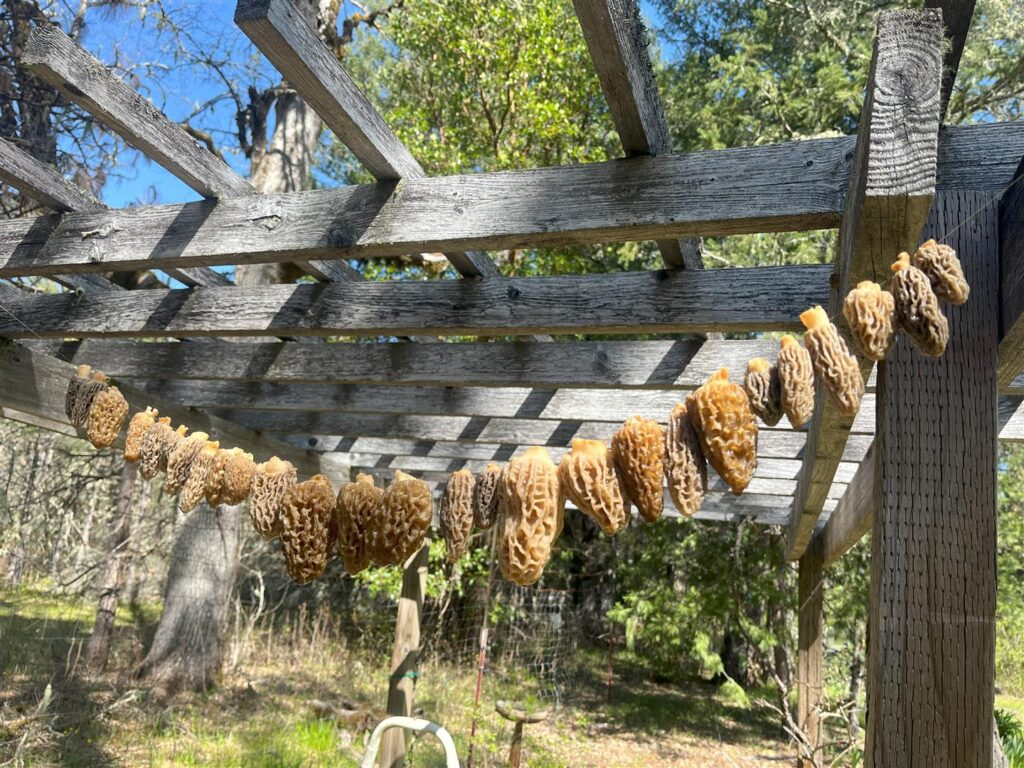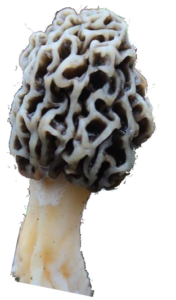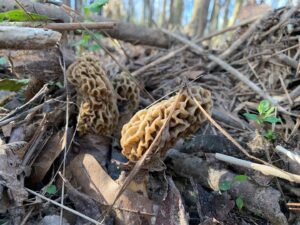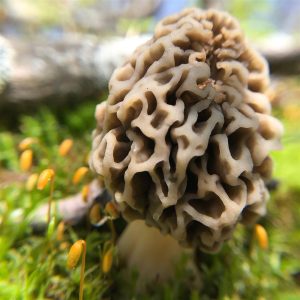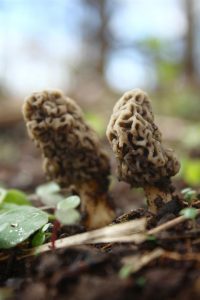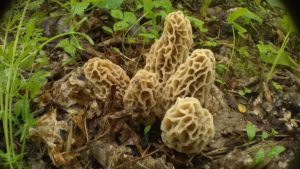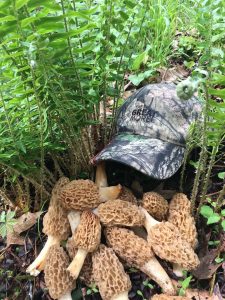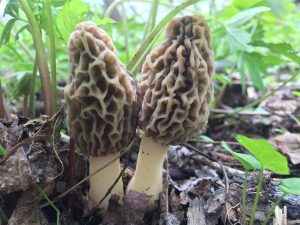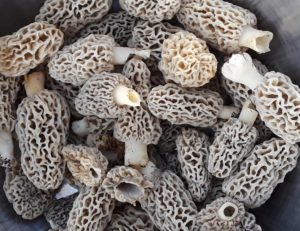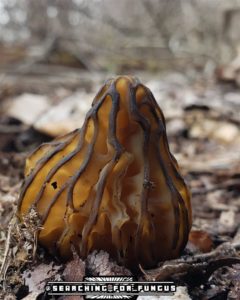This page contains suggested ways of preserving your morels for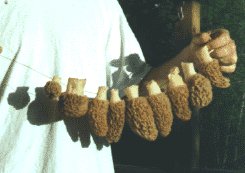 later consumption. Over the years visitors to The Great Morel have offered up these suggestions – from freeze-drying to canning, you’ll find various and interesting ways of saving them for that “out-of-season” special occasion! Click here to return to the recipe page.
later consumption. Over the years visitors to The Great Morel have offered up these suggestions – from freeze-drying to canning, you’ll find various and interesting ways of saving them for that “out-of-season” special occasion! Click here to return to the recipe page.
Also, read the great blog post article on The Complete Guide to Preserving the Morel which was published in 2020.
Preserving Quick Index
Freezing and Freeze Drying Techniques
Freeze Drying the Morel Mushroom
This detailed suggestion comes from Hayley Ryczek of HealthStartsInTheKitchen.com who offers her suggestion….
“What is your favorite way to preserve your wild foraged mushrooms?? We have tired every method of preservation and have found that hands-down the best for both quality, longevity and retaining the most nutritional value to be Freeze Drying.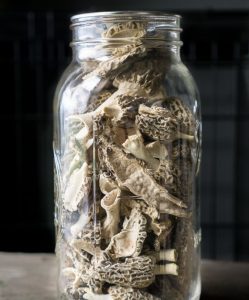
They have a shelf life of 25+ years, retain 95% of their nutrition and when re-hydrated in water and cooked, they are identical to fresh.
Currently our pantry of freeze dried mushrooms includes morels, sheephead, chicken of the woods, chanterelles, bearded tooth and black trumpets.
Purchasing a freeze dryer was one of the best investments we’ve made for preserving the freshness of wild foraged (and seasonally fresh foods). These morel mushrooms were picked last night (Thurs. 4-6-17) we brought them home, cleaned them and put them in the freeze dryer over night. Today they are packed up and will stay fresh for 25+ years.
If you are serious forager who wants the best way to preserve your harvest, click here and visit HeatlthStartsInTheKitchen.com”
Courtesy of Haley Ryczek – the voice of HealthStartsInTheKitchen
Return to Top of Page
Freezing the Morel Mushroom
“I don’t know how many folks dry or freeze any excess (ya right, who has excess). I’ve gone to freezing a couple of pounds for the winter months. After washing/soaking, I dust them with flour, put them on cookie sheet and freeze solid. The flour keeps em from sticking together in freezer bag. Works well.”
Courtesy of Doug Taylor , Normal, IL.
Return to Top of Page
A Freezing Secret
“Hello, Just found your site and thought I’d give you my freezing secret!! I clean and soak them, cut them in half, then dip them into beaten eggs, I then dip them in flour and fry them for 2 minutes on each side, remove and let cool. Place them in freezer bag and in the dead of winter when you finish frying them they taste as if you just picked them!!! Love the site, Rick ”
Courtesy of Rick , Boonville, Missouri
Steve’s Freezing suggestion
“I take my mushrooms. Slice in half,and a little soaking in salty water to get rid of bugs, then I put them in a bowl and place in the microwave oven for about a minute till they reduce down and there is water in the bottom of the bowl. Then I separate them on a cookie sheet and place in the freezer. When they have frozen I place them in a vacuum sealer bag and when I use them in recipes I can easily separate them for the amount I need.”
Courtesy of Steve
Return to Top of Page
Reggie’s Freezing Technique – Don’t use Salt
“I have found when freezing morels if when you slice them in half, just rinse them in cold water to make sure they are clean. Do Not soak them in salt water! They are much firmer with a simple rinse and don’t get as soft and mushy. Much more like fresh mushrooms when you get them out and cook them later. I just slice them in half, rinse in cold water, flour them dry and freeze them. Or I have rinsed and fried partially and then freeze. Either way I have found if you are going to freeze them, they are much better and firmer just rinsing and not soaking in salt water.
You will notice the difference when you soak them in salt water versus a simple rinse. After soaking in salt water they break down and become soft and limp. Which is ok if you are going to cook them at the moment, but not as good to preserve them.”
Courtesy of Reggie , in Iowa
Frozen Ready-To-Cook Deep Fried Morels
“I tried this today and it worked nicely. I need to experiment on how long they keep frozen but they cooked up great after being frozen solid.”
Part #1
- Prepare like your going to fry them fresh. I prefer to keep it simple.
- Cut Morels in half. Soak in salt water to remove bugs.
- Rinse and inspect for bugs and roll in a big bowl of plain flower w/a pinch of salt until nicely coated.
Part #2
- Place on a cookie sheet and freeze for 2 hours.
- Place single layer of frozen morels in a Ziploc bag and remove all access air. Vacuum pack if you can.
- Store in freezer in a protective container or space where they wont get beat up.
- Cooking instructions.
- Heat butter to frying temp. Place frozen morels in. Do not move until the first side is browned to a crisp golden color. Side two cooks fast.
Enjoy!
Courtesy of Jennifer – in WI (posted 2006)
Frozen and Vacuum Packed
“I cut them in half, then place them on a cookie sheet in the freezer just long to make them solid. Then vacuum pack them. They will not freezer burn or dry out. When you are ready, thaw and cook them how ever you want. ”
Courtesy of Glen Martin
Freeze and serve Mushroom Mike’s way….
“Hello, For the past 20 years we have harvested and preserved our Morels by putting in salt water for 20 minutes after they are sliced in half, then thourly rinse in collinder until most of water is out. Then I take large frying pan with 1/4 lb of butter and fill pan with Morels and cook for 3 min at the maximum.  Remove mushrooms from heat and store in large pan until cooled. Then we put three large spoonfuls in 1 qt freezer bags with slotted spoon to seperate from juice. After you have seperated from juice, I then add equal amounts of juice to each bag, seal then lay them flat on cookie sheet and flash freeze until thourly frozen. Then put frozen package in air tight box and store in freezer. When ready for meal of Morels, I put entire frozen pack into frying pan.( cut bag and put frozen block in pan and cover until they are thawed. Cook until they start to pop and butter is almost gone then poor on steak…Best method I have ever used….Try it, it is the best way I have found.”
Remove mushrooms from heat and store in large pan until cooled. Then we put three large spoonfuls in 1 qt freezer bags with slotted spoon to seperate from juice. After you have seperated from juice, I then add equal amounts of juice to each bag, seal then lay them flat on cookie sheet and flash freeze until thourly frozen. Then put frozen package in air tight box and store in freezer. When ready for meal of Morels, I put entire frozen pack into frying pan.( cut bag and put frozen block in pan and cover until they are thawed. Cook until they start to pop and butter is almost gone then poor on steak…Best method I have ever used….Try it, it is the best way I have found.”
Courtesy of Mushroom Mike
Another freeze and serve suggestion….
“After a thorough washing, I like to slice them in half, dry them off and roll them in flour. Place about one to two tablespoons of real butter in a large frying pan. Fry the morels about 50% of the way and then place them on a cookie sheet with wax paper so they are not touching. At that point I will put the sheet into the freezer until they are completely frozen. From there I will put them in ziplock bags and store them for the winter in the freezer. This is very simple and does not require a lot of work. I like to wait until about 6 months from the season and take some to my dads to eat. ”
“When you are ready to eat, all you have to do is get out the skillet, add very little butter and cook them the remainder of the way.”
Courtesy of Tim W – Lancaster, OH
Tim’s frozen suggestion….
“My wife and I freeze a couple of gallon bags of sponge every year. We also find a lot of spikes (what I call snake heads) every year and when we find more than we can eat my wife puts them in quart containers and covers them with water then freeze them. I take them out, thaw them and put them over a roast with potatoes, carrots and onions. Wow what a flavor they make! It is especially good on deer roast.”
Courtesy of Tim D – Indiana (added 3/27/2010)
Freezing morels in milk cartons:
I began hunting morels with my dad when I was about 5 years old. That was 45 years ago. Every year I’ve frozen the morels using the same method he taught me and it has proven to be a tried and true method for preserving those delicious morsels. After the day of hunting is through take the morels, slice them in half and soak them in a sink of cold salted water to kill any critters hiding inside. After soaking, take a clean paper milk carton, fill it with the morels, cover them with water (leave enough head space to allow for expansion) and place the carton in the freezer. This will freeze your morels a block of ice. When it’s time to thaw them, just take the carton out of the freezer, sit it in the sink, and allow the ice to thaw. You’ll have morels that are as fresh and as tasty as the day you picked them. Cook as usual and enjoy!
Courtesy of Debbie in the great state of Texas
More Freeze Dried…and Unfreezing…
“I so much enjoyed your recipes from the Great Morel Site! I am an avid shroomer myself and am fortunate enough to have a cottage in Northern Michigan. You can only find me on May weekends there in the woods enjoying the smells of wild onions and the great beauty of tiger lillies, trillium and morels.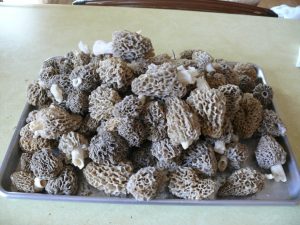
We eat lots of fresh morels, but I also freeze and dry them so that we can enjoy them throughout the year. For the morels that I freeze, I first clean them in water, draining on paper towels. They are then sauteed in butter with chopped shallots and fresh parsley, along with heavy cream and sometimes dry sherry. I store them in small soft margarine containers, wrapped in plastic, and marked with dates and contents. We carefully measure their use throughout the summer, fall and winter months and sometimes are lucky enough to have one or two left the following May.
I use the frozen morels, mostly with boneless chicken that has been dusted in seasoned flour, sauteed in butter with cream and sherry, adding the tub of morels at the end to heat. It is one of our favorite meals. I also use them in rissoto and pasta fettucine, both with lots of fresh parmesan. Here’s to a good hunting season in ’99!”
Courtesy of Sheryl Kendrick
Preserving Quick Index
Dehydrating – Air Drying Techniques
Dehydrating the Morel Mushroom
“I like to dehydrate my surplus mushrooms for future feasts. It is a treat to have them for Thanksgiving & Christmas. I rehydrate them in half & half or milk until tender, then I flour them up and fry in butter. I save the milk and make gravy with it. Best stuff in the world.”
Courtesy of Andrea Randleman
A unique and amazing utilization…
Last year I had a fantastic morel hunt. Even giving some away and eating till I was bloated, I was faced with a preservation dilemma.
Here’s the story of what I did (it’s the RESULT that make this unique).
- 1. Cut in half lengthwise and clean (dollar store nylon brush slightly larger than a toothbrush), using as little water and scrubbing pressure as possible.
- 2. Large ones get cut in half lengthwise again.
- 3. Standard home dehydrator, 12 hours minimum.
- 4. When thoroughly dry, store in airtight kitchen cannister.
RESULTING USAGE:
Went on a week-long canoe trip three months later. While sitting around the campfire drinking beer, we placed large pinches of dried shrooms between our cheeks and gums (like a baseball player with chewing tobacco). And just left ’em there.
It takes awhile, ten minutes or so, for your saliva and the heat of your mouth to rehydrate the shrooms to where they start releasing their flavor, but once the process gets going… WOW! More than an hour of continual, INTENSE shroomy goodness per “chaw.”
We actually stopped drinking beer so as not to attenuate the taste experience (and getting me to stop drinking beer in camp usually requires a gun and a badge).
Note well: You must resist the temptation to use your teeth… what we have here is time-released shroom juice.
Courtesy of Craig
A “from the begining to the end” suggestion:
Nice web site, but I about passed out when I read the preservation suggestions. We’ve been hunting morels since we were kids in the 1950’s. This year has been especially good!
Like any mushroom, and perhaps even more than most, the morel will absorb water if washed or soaked. This not only dilutes the flavor, but destroys the texture or bite.
Never wash or soak a morel. The need to do so is minimized if one harvests them correctly. Pinch off the mushroom just below the “head.” Carry your morels in a spore bag (never, ever use a bucket or plastic bag that does not deposit spores on the forest floor). If your spore bag has relatively large holes, much of the forest floor “debris” will fall off the heads and onto the forest floor as one walks about.
At home, spread out the morels on cotton towels. Cut each one–one at a time–into halves or quarters (depending on how lucky and how big the find). Expect to find pill bugs and many-legged insects inside, so keep the garbage can close by. Flick the living critters outta’ there! Use the tip of a knife blade to remove any brown spots that might be critter poo poo from the inside of the morel. The outside is generally quite clean. A simple brushing with a soft bristle brush, such as a good quality basting or pastry brush, will clean up the outside.
If you can resist eating them all right away, either tossed with fresh sage and quickly sautéed or tempura battered and fried, dry them for a special occasion dinner.
To dry the morels, spread them on a screen or rack. A stove top down draft vent is an ideal “dryer.” Simply turn the down draft on low and in 12 hours, they’ll be perfectly dried. No stovetop down draft vent? Place an oscillating fan in front of the morels and let it blow, let it blow, let it blow. Dehydrators will produce either good or disastrous results. If it’s a commercial quality dehydrator, results will be excellent. The cheap plastic things with light bulbs will produce too much humidity and ruin the morels.
The dried morels keep very well in a vacuum bag in a cool, dark place. Don’t have one of those neat vacuum bagger machines? Toss them in a freezer bag and store them in the deep freeze. No freezer, store them in a tightly sealed jar in a cool, dark place.
To re-hydrate a dried morel, bring some chicken broth (beef broth is too overpowering) to a boil. Pour it over some dried morels. They will rehydrate and puff up. Julienne the mushrooms and use the broth to make a gravy…clear gravy is made with cornstarch/rich, cream gravy is made with cream and flour. It’s fabulous over pheasant crepes or rice timbales! Or,make morel soup! Put the rehydrated morels and broth in a blender and pulse on high until smooth. Add cream cheese chunks and more heated broth until the desired consistency and taste results. Serve crusty bread, tomato spread and tossed mesclan salad for a dinner straight from heaven!
Courtesy of a Seasoned Morel Hunter
String Dried Version….
I tried something 4 years ago and darn if it doesn’t work. In 1999 I was lucky enough here in Ohio to find a hugh amount of morels one day. Too many to eat before they would go bad. So I tried this method of drying them. If you feel that any of the visitors to your site would like this information (it works, so I know they will), go ahead and post it and my address on you web.
Take a large size sewing needle, large enough to handle some heavy thread. I found some in my wife’s sewing basket.
Thread each morel through the base of the stem (just like stringing popcorn for the Christmas tree) and hang them upside down in the garage. Tie the two ends of the thread as far apart as necessary to insure that the morels do not touch each other. The tighter you stretch the thread the easier it will be to keep them from touching together. Now just let them hang there and dry out.
Once they are thoroughly dried (I left mine hang for many months) place the morels in a simple zip lock bag and store in the refrigerator.
This year I found 20 and my wife & I enjoyed them as usual. That’s all I could find this year so I decided to try the ones I dried in 1999. I soaked them over night, drained them good and patted them dry in paper towels and fried them as if they were fresh and guess what. We could not tell the difference in the dried ones and the fresh ones, honestly. Be sure and use a large bowl or pot because they will swell back up to their original size.
I believe that they would have stayed good in my refrigerator indefinitely.
I am 59 years old and have hunted morels ever since my dad took me out the first time when I was 3 years old. I am so happy to have discovered this easy method of preserving a good haul. From now on, I’ll be stringing popcorn, uh, I mean morels every spring knowing that I can enjoy this wonderful treat all year long.
There it is, try it everyone……it really works.
Courtesy of Art , in Dayton, Ohio
Air Drying….
I’m fairly new to Morel Hunting, (about 5 yrs)…and this year, 2003, has been a winner. We ate, we shared, we ate somemore.
When it came time to try and store them….the suggestion was made to dry them….. One of the 23,000,000 experts on the subject told us to lay out some Window screens (we used hardware cloth stretched between two 2×4’s) on the deck. Spread the mushrooms out whole and uncleaned in the direct sunlight for the day, or until dry…
Worked Great! They were completely dry in about 6-7 hrs. It was a sunny, 74 degree day with a light breeze. We were told to store them in a paper sack.
I’ll report back this fall when we eat our fill.
Courtesy of Dave , in Iowa
An Alternative Way To Dehydrate
Here is another method of preserving your spring harvest ( for those without a dehydrator):
After soaking, washing and pat drying the morels, get out the needle and thread. Remove one or both racks from your oven, depending on how many shrooms you plan to dry. Tie the end of the thread onto one of the racks. Thread a few of the shrooms through the stem, then loop the thread around one of the wires on the rack. Thread a few more shrooms. loop the thread around the wire. Continue from one side of the oven rack to the next, and back and forth until you run out of shrooms or you decide that the rack is full. Then tie the end of the thread to the rack. If you run out of thread, start over with a new piece.
Carefully place the rack back into the oven on the highest level so that the shrooms are suspended below the rack. You should be able to do the other rack at the same time. Set the oven to warm – approximately 160 degrees. Check after about 8 hours. You want them to be completely dry. They will be hard and very light.
I have some that were lost, then found again two years later. Though not as good as fresh, they still worked great in a steak sauce!
Courtesy of Dave in Des Moines, Iowa
Another version of String Dried:
My husband and I enjoyed your website and found portions of it quite humorous. My husband has been an avid “shroomer” for twenty-five years in the hills of Kentucky. His advise for preserving morels is to string them on dental floss, hang by the refrigerator for about 1 day, then store in quart jars in the freezer. They can either be crumbled for seasoning or rehydrated with milk at any time. This method of preserving will make the mushroom last for several years. Hope you enjoy this quick and convenient method.
Courtesy of Barbie R.
Preserving Quick Index
Other Preserving Techniques
A “Canning” recipe
Note from the Great Morel – please read this caution that proceeds this suggestion regarding canning.
I found a canning recipe and I think I might like this better than freezing or drying.
Sterilize wide mouth pint canning jars and add 1 teaspoon canning salt.
Fill jars with Morels……They sure look pretty when I set the morels in the jar stem down around the outside and stacked full and tight in the center.
Add room temperature distilled water or reverse osmosis (r/o) water straight from the tap
Pressure cook for 30 mimutes at 10 lbs pressure.
BOY do these look beautiful…….when the mushrooms come out of the pressure canner there look like the jar has alot of water on the bottom….when cooled the morels seem to sink toward the bottom …..They look and taste GREAT. This recipe was given to me by a migrant morel hunter and he claims to have gotten the recipe from an old Amish cookbook.
NOTE: DON’T throw the the water you drain off the mushrooms away …add it to your gravy ……..ITS the BEST.
Follow up note: Make sure you note that mushrooms of any type should never be canned in quarts…..pints or half pints/jelly jars. Hope anyone that tries the recipe enjoys them as much as myself.
Courtesy of Cindy , in Ohio
Word of caution from another shroomer: “I am e-mailing others with the information I have obtained about canning morel mushrooms. After talking with the County Extention office they had informed me that canning morels could be lethal. Morel mushrooms have toxic hydrozines and while cooking them this evaporates into the air but when canning these those toxins have no where to evaporate to so they go back into the mushrooms which form a botulism and can be deadly when ate. There is no safe pressure or poundage that they have come up with in order to pressure can these mushrooms. The National Center for Home Food Preservation is a good source when canning foods and they can be contacted at www.uga.edu/nchfp
Please let others know. I dumped the cans of mushrooms after obtaining this information and hope others do the same. The best way of preserving mushrooms is to freeze them. Thank you for allowing me to pass this information on.”
Courtesy of – Lynnette M
More Canning Suggestions
While you are correct about the poisons I have two (2) separate canning recipes.
One requires you to precook the morels before canning by either, heat do not boil in just enough water to prevent sticking,
The second is to steam morels and use the water used in steaming to refill canning jars.
They are awesome!!
Courtesy of Scooby Doo
A simple suggestion:
Please don’t tell people to cover their shrooms with paper towels. I put paper towels between layers once and all my shrooms tasted like paper. I put them on older cotton towels and they keep perfectly.
Courtesy of Maynot
Brown Bag preserving:
I’ve found that keeping morel mushrooms in a brown paper lunch bag in your refrigerator keeps them from shrinking – as opposed to dehydrating them. They will shrink a little, but not even close to the dehydrating them quickly.
Just set the closed paper bag in the fridge and forget about it. Really! I’ve done this for years. It will dry up and retain its shape and color. I’ve already put a few big ones that I’d like to keep this year in the fridge (to show friends that are less fortunate, and can’t find them, what they look like). My grandfather taught me this. If you ever decide on eating them later, soak them in chicken broth, for a few hours, before cooking. I’ve found that the mushrooms, once dried out, seem to last forever – if kept in the bag and in the fridge.
Good luck to your future hunting!
Courtesy of Jon J. Czuhai
Follow-up from Jon on his technique:
Clean and soak them first with cold salt water – as normal to get any bugs and slugs out. Then pat them dry before putting them in the bag. You could just throw them in any order, in the bag, if you don’t care to keep them as their perfect shape when dried.
Truthfully, last year, I put multiple brown paper lunch bags, layered between mushrooms, all in a large grocery, brown paper bag. When they were dry I dumped them all together in one bag. This method is used to form perfect looking dried mushrooms.
You can’t put a bunch of them together until they are already dried. If you want to dry them, while keeping their original shape, keep them separated while in the brown paper bag.
Courtesy of Jon J. Czuhai
Markie’s Preserving Technique…
I like mushroom sandwiches. sauted morels on a good dry-toasted sourdough is yum. So in order to enjoy this in December, this is what I do.
When I’m picking, I have a plastic mesh bag and a lunch sack paper bag inside it. The obviously dirty morels go in the the plastic bag and the clean ones in the paper bag. Once home they are thumped on the counter then placed in a bowl. Water is added to the bowl and the morels are agitated and thumped against the side of the bowl. They are then transferred to a new rinse bowl, knifed in half (inside flushed if necessary) covered with new water and agitated and thumped. Once cleaned, in a ten-inch skillet one-half cup of water is brought to a boil. The mushrooms are added insides down (about 12 nice whites), covered with a lid and allowed to boil for a minute and an half. The product is poured back in to the bowl and allowed to cool a bit.
Having a vacuum plastic bag sealer, I find a casserole dish about the same width as the bag and take the morels and boil water, pour them into the bag and place it in the dish and express the air. Then stick in the freezer. Once frozen, I seal.
Come eating time, the thawed bag’s water is boiled with butter and maybe some garlic until the water is almost gone and then the ‘shrooms are added for a minute or so. the ‘shrooms and butter are poured on the dry toast and eaten. Almost as good as the day they were picked.
Courtesy of Markie
Keeping Them Fresh – Ted’s Technique…
I apologize for taking so long to reply to you on how to keep and de-bug morels. My method also works on oyster mushrooms although they don’t keep as long.
-
- 1. Sort out any fresh picked morels that should be eaten (mature, stained, etc.)
- 2. Place the remainder of your morels in a clean, stainless steel bowl.
- 3. Cover the top of the bowl with clean heavy duty paper towels (two layers) and mist the paper towels with clean cool water.
- 4. Cover the paper towels with one layer of wax paper.
- 5. Now place a hand or small bath towel over the entire bowl and place in the fridge.
- 6. Every two to four days check your mushrooms and sort those that need eating, remove slugs, etc. from the under side of the paper towels and the sides of the bowl, re-mist the paper towels and place back in the fridge.
- 7. Any mushrooms you eat should be cut in half lengthwise to check for any remaining “bugs” if any.
Soaking morels in salt water only kills the bugs and leaves them inside the water soaked and softened morel. Salt water is a trick for broccoli, not mushrooms.
Caution: This method works for me every year but the little known and usually mis-identified ‘half free morel’ (Morchella Semilibra) is very delicate and will only last a few short days. This morel is best eaten fresh.
It is a VERY tasty morel and often only comes up every two to three years. I am lucky enough to have found three large patches of the half free morel that come up every year. If you find any, I suggest that you try them. You won’t be disappointed. I hope you find this useful and continue your shroom quest.
Courtesy of Ted Grossmeyer from Empire, Michigan
No Freeze Morel – Mushroom Powder and Pickling them…
I’ve been checking in with your site for a couple years now, and thought I might chime in for the “Preserving” Department. I am lucky enough to live in the fertile Willamette Valley of the Pacific Northwest, and have been picking numerous fungi for many years. Needless to say, around here any passionate shroomer with a reliable car will often have more than enough fungus for themselves, their friends, for bartering and for storage. Although freezing is the generally accepted “best method” of storage, I have never had a sizable freezer capacity (such as a chest freezer or stand-alone) – and the small ice box in the top of my fridge is usually reserved for meat & ice cream. In this respect, I can only assume I am one of many. I am an avid wild food forager of all types, and have always relied on my pantry for long-term storage – usually dried or pickled, just like the ancients. Mushrooms are no exception. 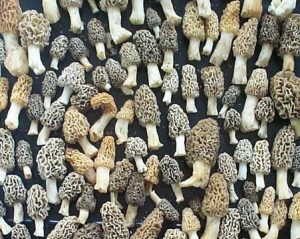
I thought I would share two of my favorite shroom-saving methods, both of which will give you a product very unlike the fresh mushroom – that is, if you want to maintain as much integrity of freshness as possible, then dry or freeze them. But if you like to play with your food, make your own ingredients, or improvise your daily menu, then I would suggest making mushroom powder or pickling them.
Mushroom powder is a high-priced snob-store delicacy that you can make at home for absolutely nothing. It is a fantastic addition to your spice cabinet, and can be used as: a soup stock, to flavor grains & stuffings (add to water before cooking), as a dredge (add to the flour or coating mix of fried food like chicken, fish or veggies), or a flavor enhancer (what the Japanese call “umami”) for gravies & pan sauces. Use it almost as you would dried mushrooms, but in applications where you want the flavor without the substance. It lends a rich mushroom “essence” to any recipe it is applied. (Use this method to make powder out of any mushroom).
– Clean the mushrooms as to your standard procedure (w/ or w/o water or salt or pre-cooking or not – it doesn’t matter)
– Slice morels in half or quarters, and thoroughly dehydrate (any drying method will work, but must be completely dry before proceeding)-Toast the dried morels in a 200° oven for 10-15 minutes, or until they start to smell aromatic (they scent of toasted earthiness should hit you as soon as you open the oven door)
– Spread out in thin layers to cool – don’t pile them up in a bowl to cool, because they can produce condensation inside the bowl, and will need to be re-dehydrated. Baking sheets, serving platters and window screens would all work well.-Working in small batches (about 1 cup at a time) grind the morels to powder in the blender. Start by pulsing a few times to break them up, and then 10-15 seconds on high. Sift this, or knock it through a wire strainer, to separate any bigger pieces that need to go back in the blender.
– Once everything is ground & sifted, add 1/4 teaspoon each of salt & pepper and 1/2 teaspoon of cornstarch for each 1 cup of morel powder. (The cornstarch prevents caking, and is completely optional. The small amount of salt & pepper round-out the earthiness of the morels – I use powdered salt & powdered white pepper so it assimilates nicely into the mushroom powder for a consistent texture. For powdered salt, just zap some sea salt in the blender until it’s a fine texture.)
– Mix thoroughly & store in a jar with a tight-fitting lid. This is better than any commercial soup stock, with much less salt, and no preservatives. About 4 pounds of morels will yield about 1 pint of powder.
The Pickling Recipe…
The pickling recipe I use for mushrooms is fantastic, and I use it for morels, chanterelles, matsutake, hedgehog, bolete & leccinum caps and even corals (not so good with lobsters, sulphur shelf or hen of the woods, though). I like to use white wine vinegar, but cider vinegar is good too, as is cane vinegar (available from your Asian grocer) as long as it has 5% acidity. Make sure you check the label – Rice wine vinegar would be good too, but has less acidity and is unsuitable for canning. Also, this recipe does not pose the same botulism threat as the recipe for fresh-canned morels, for two reasons: 1)the mushrooms are cooked thoroughly before processing, and 2) the acidity level is high enough to prevent botulism growth. The dangers of botulism in canned food is no joke, and definitive sources on home food-preservation science have always advised against fresh-canned wild mushrooms (even though you can always find an old-timer who has “always done it this way before…”). Salt or vinegar based brines, like this one, is the only accepted safe way around it. And safety is always good – delicious just makes it better! Use these as a stand-alone pickle, on an appetizer plate or chopped into pasta salad.
Ingredients (Makes 7-8 half pints) 2 pounds mushrooms 3 cups vinegar of at least 5% acidity (check the label) 1 cup water 1 cup dry white wine 1/3 cup sugar 2 tablespoons pickling salt 16 black peppercorns 16 coriander seeds 8 dried bay leaves
– Prepare your canner, jars and lids as per the manufacturer’s directions
– Wash mushrooms, dry with towels or salad spinner, and cut in halves or quarters
– Combine the vinegar, water, wine, sugar & pickling salt in a large pot. Bring the mixture to a boil and then add the mushrooms. Bring the mixture back to a boil, then reduce the heat and simmer for 5 minutes.
– To each hot, sterilized jar, add 2 pepper corns, 2 coriander seeds and 1 bay leaf. Then fill with hot mushrooms leaving 1/2 inch headspace at the top of each jar. Cover the mushrooms with hot pickling liquid.
– Thoroughly wipe the rims and threads of the jars, set the lids and screw on the rings. Any jar that has more than 1/2 inch headspace should be refrigerated, not processed.
– Process for 10 minutes in a boiling water canner. Let cool for 12 to 24. To test the seal, press down on the lid – it should not move.
– Allow the pickle to cure for at least 2 weeks before using. The pickled wild mushrooms will keep for up to 1 year.
– Discard if at any time the mixture looks moldy, foamy or murky, or if it does not smell right when opened.
Well, that’s my 2 cents worth – this ended up being longer than I thought it would, so if you choose to share it, please feel free to edit for brevity or clarity. I love what guys like you & matsiman & wildman Steve Brill do for the world of foraging – takin’ it from mythology to methodology.
Thank you much, and happy hunting!
Courtesy of Chad – in Eugene, OR
Shawna from Wyoming offers this thought: I would highly recommend doing this outdoors or on and enclosed patio on a windless day. It produces a lot of fine dust and is bad for people with allergies. I’m not usually too sensitive to pollen, dust, etc. but this made me sneeze a lot. Just thought I would add that little note.
Par boiling the Morel Mushroom
“For over 25 years we have used this method as one of our preserving options. Place clean morels in boiling water, when the water returns to a boil in a few minutes, remove the morels in a strainer, and lay them out on paper towel to dry. Then freeze them in freezer bags in a single layer, removing as much air as possible. This par boiling method kills the bacteria that can ruin morels, even in the freezer. When thawed they pop up and are close to fresh, with a better texture than reconstituted dried morels.”
Note: morels preserved this way should be used within a year’s time.
Courtesy of Greg S – from Hanover, IL (posted 2020)
Return to Top of Page
